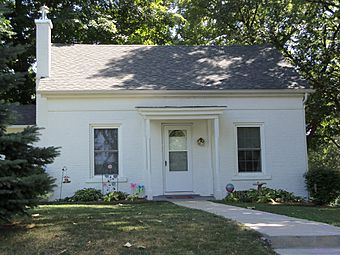John Smith House (Le Claire, Iowa) facts for kids
Quick facts for kids |
|
|
John Smith House
|
|
 |
|
| Location | 426 Dodge Le Claire, Iowa |
|---|---|
| Area | less than one acre |
| Built | 1852 |
| MPS | Houses of Mississippi River Men TR |
| NRHP reference No. | 79003705 |
| Added to NRHP | April 13, 1979 |
The John Smith House is a historic building in Le Claire, Iowa, United States. It was built in 1852. This house is special because it has been listed on the National Register of Historic Places since 1979.
The John Smith House is part of a group of homes called the Houses of Mississippi River Men Thematic Resource. This group includes houses of important men from Le Claire. These men worked on the Mississippi River as captains, pilots, builders, and owners of riverboats.
Who Was John Smith?
John Smith was the son of Ira Smith, one of the people who helped start the town of Le Claire. John Smith became famous for his work on the Mississippi River.
In 1856, a steamboat called the Effie Afton hit a new railroad bridge. This bridge was between Davenport, Iowa and Rock Island, Illinois. The railroad company hired John Smith to prove that steamboats could safely pass under the bridge.
At first, other river captains did not want to hire Smith. This was because railroads and steamboats were competitors. But by the 1860s, Smith became a respected river pilot.
John Smith also helped invent new types of boats. He worked with the Van Sants, another family from Le Claire. Together, they created the "raftboat." This boat pushed large rafts of lumber down the river. The lumber came from northern forests and went to mills further south. They also developed the "bowboat." This was a small boat placed at the front of a raft. It helped steer the raft and gave it more control.
About the House
The John Smith House is a small, one-story building. It is made of brick and sits on a strong stone foundation. The house has a main hallway in the middle.
The front of the house has three main sections, and the sides have two. A small porch covers the main entrance. This porch has a flat roof supported by thin wooden posts. The windows have flat stone tops, called lintels, and stone bottoms, called sills.
A wide wooden band, known as a frieze, runs across the entire front of the house. It has a decorative edge at the bottom. The house has a gable roof, which is a pointed roof. A small, one-story wooden room was added to the east side of the house later.



